Metabolic tumor volume assessed by 18F FDG - PET CT scan as a predictive biomarker for immune checkpoint blockers in advanced NSCLC and its biological correlates
IF 10
1区 医学
Q1 ONCOLOGY
引用次数: 0
Abstract
Purpose: This study aimed to explore metabolic tumor volume (tMTV) as assessed 18F-fluorodeoxyglucose positron emission tomography-computed tomography (18F-FDG-PET/CT), and understand its biological meaning in patients with NSCLC exposed to immune checkpoint blockers(ICBs). Experimental Design: In this study, patients with advanced NSCLC and a positive PET scan within 42 days of first line treatment were enrolled in 11 institutions across 4 countries. Total MTV (tMTV) was analyzed, with a 42% SUVmax threshold. Survival was analyzed according to high tMTV (≥ median). Plasma proteomic profile, whole exome, transcriptome and other analysis were performed on monocentric cohorts to explore its biological correlates. Results: Of the 518 patients included, 167 received ICBs, 257 had chemotherapy plus ICBs, and 94 had chemotherapy. Median tMTV was 99 cm3. Median overall survival (OS) for patients with high tMTV treated with ICBs was 11.4 months vs 29.6 months (P<0.0012) for those with low tMTV. In patients receiving chemotherapy-ICB tMTV did not correlate with OS (P=0.099). In patients with PD-L1≥1% and high tMTV, chemotherapy-ICB combination was associated with longer OS compared with ICBs alone (20 vs 11.4 months,p=0.026), while no survival differences observed in low tMTV group. High tMTV correlated (and its detrimental effect seems to be driven by) a specific proteomic profile and increase in genomic instability. Conclusion: Our analysis indicates high tTMV is linked to an increase in systemic inflammation, specific cytokines production and chromosomal instability. tTMV may serve as one of the biomarker to select the best upfront strategy in patients with PD-L1 positive advanced NSCLC.将 18F FDG PET CT 扫描评估的代谢肿瘤体积作为晚期 NSCLC 免疫检查点阻断剂的预测生物标记物及其生物学相关性
目的:本研究旨在探讨18F-氟脱氧葡萄糖正电子发射计算机断层扫描(18F-FDG-PET/CT)评估的代谢肿瘤体积(tMTV),并了解其在暴露于免疫检查点阻断剂(ICBs)的NSCLC患者中的生物学意义。实验设计:在这项研究中,4个国家的11家机构招募了接受一线治疗42天内PET扫描呈阳性的晚期NSCLC患者。以 42% SUVmax 为临界值,对总 MTV(tMTV)进行分析。根据高 tMTV(≥ 中位数)分析生存率。对单中心队列进行血浆蛋白质组、全外显子组、转录组和其他分析,以探讨其生物学相关性。结果显示在纳入的 518 例患者中,167 例接受了 ICBs,257 例接受了化疗加 ICBs,94 例接受了化疗。tMTV中位数为99立方厘米。接受ICB治疗的高tMTV患者的中位总生存期(OS)为11.4个月,而低tMTV患者为29.6个月(P<0.0012)。在接受化疗-ICB的患者中,tMTV与OS无关(P=0.099)。在PD-L1≥1%且tMTV较高的患者中,化疗-ICB联合治疗与单用ICB相比,OS时间更长(20个月 vs 11.4个月,P=0.026),而在低tMTV组未观察到生存率差异。高tMTV与特定的蛋白质组特征和基因组不稳定性的增加相关(其不利影响似乎是由其驱动的)。结论我们的分析表明,高 tTMV 与全身炎症、特定细胞因子的产生和染色体不稳定性的增加有关。tTMV 可作为生物标记物之一,用于选择 PD-L1 阳性晚期 NSCLC 患者的最佳前期策略。
本文章由计算机程序翻译,如有差异,请以英文原文为准。
求助全文
约1分钟内获得全文
求助全文
来源期刊

Clinical Cancer Research
医学-肿瘤学
CiteScore
20.10
自引率
1.70%
发文量
1207
审稿时长
2.1 months
期刊介绍:
Clinical Cancer Research is a journal focusing on groundbreaking research in cancer, specifically in the areas where the laboratory and the clinic intersect. Our primary interest lies in clinical trials that investigate novel treatments, accompanied by research on pharmacology, molecular alterations, and biomarkers that can predict response or resistance to these treatments. Furthermore, we prioritize laboratory and animal studies that explore new drugs and targeted agents with the potential to advance to clinical trials. We also encourage research on targetable mechanisms of cancer development, progression, and metastasis.
 求助内容:
求助内容: 应助结果提醒方式:
应助结果提醒方式:


